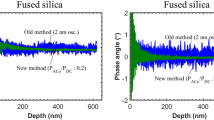Abstract
The primary tool for mechanical characterization of surfaces and films is instrumented indentation using the Oliver-Pharr data analysis method. However, this method measures contact area between the indenter and sample indirectly, thus confounding instrumented indentation tests when characterizing dynamic properties, thin films, and materials that “pileup” around the indenter. Here, we demonstrate an electrical technique to continuously measure the in situ contact area by relating nonlinear electrical contact current–voltage (I–V) curves to the instantaneous contact area. Using this approach, we can obtain hardness as a continuous function of applied force.




Similar content being viewed by others
References
B. Bhushan X. Li: Nanomechanical characterisation of solid surfaces and thin films. Int. Mater. Rev. 48, 125 2003
S.J. Bull: Nanoindentation of coatings. J. Phys. D: Appl. Phys. 38, R393 2005
A. Gouldstone, N. Chollacoop, M. Dao, J. Li, A.M. Minor Y.L. Shen: Indentation across size scales and disciplines: Recent developments in experimentation and modeling. Acta Mater. 55, 4015 2007
G.M. Pharr W.C. Oliver: Measurement of thin film mechanical properties using nanoindentation. MRS Bull. 17, 28 1992
W.C. Oliver G.M. Pharr: An improved technique for determining hardness and elastic modulus using load and displacement sensing indentation experiments. J. Mater. Res. 7, 1564 1992
W.C. Oliver G.M. Pharr: Measurement of hardness and elastic modulus by instrumented indentation: Advances in understanding and refinements to methodology. J. Mater. Res. 19, 3 2004
T.Y. Tsui G.M. Pharr: Substrate effects on nanoindentation mechanical property measurement of soft films on hard substrates. J. Mater. Res. 14, 292 1999
S.M. Han, R. Saha W.D. Nix: Determining hardness of thin films in elastically mismatched film-on-substrate systems using nanoindentation. Acta Mater. 54, 1571 2006
R. Saha W.D. Nix: Effects of the substrate on the determination of thin film mechanical properties by nanoindentation. Acta Mater. 50, 23 2002
A. Bolshakov G.M. Pharr: Influences of pileup on the measurement of mechanical properties by load and depth-sensing indentation techniques. J. Mater. Res. 13, 1049 1998
Y.T. Cheng C.M. Cheng: Effects of “sinking in” and “piling up” on estimating the contact area under load in indentation. Philos. Mag. Lett. 78, 115 1998
I.N. Sneddon: The relation between load and penetration in the axisymmetric boussinesq problem for a punch of arbitrary profile. Int. J. Eng. Sci. 3, 47 1965
W.C. Oliver J.B. Pethica: Methods for continuous determination of the elastic stiffness of contact between two bodies. U.S. Patent No. 4 848 141, July 18, 1989
J.B. Pethica, R. Hutchings W.C. Oliver: Hardness measurement at penetration depths as small as 20 nm. Philos. Mag. A 48, 593 1983
X. Chen J. Vlassak: Numerical study on the measurement of thin film mechanical properties by means of nanoindentation. J. Mater. Res. 16, 2974 2001
A.B. Mann, D. van Heerden, J.B. Pethica, P. Bowes T.P. Weihs: Contact resistance and phase transformations during nanoindentation of silicon. Philos. Mag. A 82, 1921 2002
S. Ruffell, J.E. Bradby, J.S. Williams O.L. Warren: An in situ electrical measurement technique via a conducting diamond tip for nanoindentation in silicon. J. Mater. Res. 22, 578 2007
V. Koval, M.J. Reece A.J. Bushby: Ferroelectric/ferroelastic behavior and piezoelectric response of lead zirconate titanate thin films under nanoindentation. J. Appl. Phys. 97, 74301 2005
A. Rar, G.M. Pharr, W.C. Oliver, E. Karapetian S.V. Kalinen: Piezoelectric nanoindentation. J. Mater. Res. 21, 552 2006
S. Sridhar, A.E. Giannakopoulos S. Suresh: Mechanical and electrical responses of piezoelectric solids to conical indentation. J. Appl. Phys. 87, 8451 2000
V.R. Howes, H.J. Goldsmid C.A. Baird: Hardness measurement at constant depth using an indenter partially coated with a conducting film. J. Phys. E: Sci. Instrum. 20, 1507 1987
R. Holm: Electric Contacts: Theory and Applications Springer-Verlag New York 1967 516
R.S. Timsit: Electrical contact resistance: Fundamental principles in Electrical Contacts: Principles and Applications edited by P.G. Slade Marcel Dekker 1999 1073
L. Wieczorek, V.R. Howes H.J. Goldsmid: Electrical contact resistance and its relationship to hardness. J. Mater. Sci. 21, 1423 1986
H.J. Goldsmid, V.R. Howes C.A. Baird: Measurement of hardness using a semiconductor diamond indentor. J. Mater. Sci. Lett. 6, 1043 1987
Y.Y. Lim M.M. Chaudhri: The effect of the indenter load on the nanohardness of ductile materials: An experimental study on polycrystalline work-hardened and annealed oxygen-free copper. Philos. Mag. A 79, 2979 1999
A.C. Fischer-Cripps: Nanoindentation Springer-Verlag New York 2004 266
M.A. Lampert P. Mark: Current Injections in Solids Academic Press New York and London 1970 351
W.H. Press, S.A. Teukolsky, B.P. Flannery W.T. Vetterling: Numerical Recipes in Fortran: The Art of Scientific Computing 3rd ed. Cambridge University Press 2007 1356
Properties and selection: Nonferrous alloys and special-purpose materials in Metals Handbook Vol. 2, ASM International 1990 1328
J.R. Taylor: An Introduction to Error Analysis: The Study of Uncertainties in Physical Measurements University Science Books 1997 327
W.D. Nix H. Gao: Indentation size effects in crystalline materials: A law for strain gradient plasticity. J. Mech. Phys. Solids 46, 411 1998
Acknowledgments
This work was funded by United States National Science Foundation through program No. 0528234. This publication was also supported by the Pennsylvania State University Materials Research Institute NanoFabrication Network, the National Science Foundation Cooperative Agreement No. 0335765, and National Nanotechnology Infrastructure Network, with Cornell University. A. Romasco and C.L. Muhlstein acknowledge the support of the 3M Foundation and Corning, Inc. We also thank Prof. Patrick Lenahan, Prof. Mark Horn, Prof. Suzanne Mohney, Kedar Shah, Chad Eichfeld, and Patrick Raynaud for useful discussion and assistance with this work.
Author information
Authors and Affiliations
Corresponding author
Rights and permissions
About this article
Cite this article
Fang, L., Muhlstein, C.L., Collins, J.G. et al. Continuous electrical in situ contact area measurement during instrumented indentation. Journal of Materials Research 23, 2480–2485 (2008). https://doi.org/10.1557/jmr.2008.0298
Received:
Accepted:
Published:
Issue Date:
DOI: https://doi.org/10.1557/jmr.2008.0298




